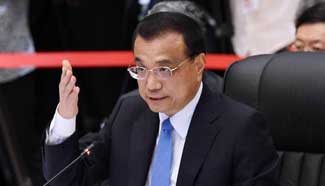WASHINGTON, Sept.8 (Xinhua) -- U.S. Republican presidential nominee Donald Trump on Wednesday laid out his hawkish defense plan which would allow the spending of billions of extra U.S. dollars to expand every branch of the military, pledging an end to mandatory budget caps.
"As soon as I take office, I will ask Congress to fully eliminate the defense sequester and will submit a new budget to rebuild our military," Trump said at a rally in Philadelphia.
"This will increase certainty in the defense community as to funding, and will allow military leaders to plan for our future defense needs," he told the crowd, reading from a teleprompter.
The sequestration measures that went into effect in 2013 affected both military and non-military spending. It is unclear whether Trump believes the cuts to non-military spending should remain.
The latest remarks were seen as a sharp turn from his previous stand since the New York billionaire once repeatedly blasted the Capitol for excessive defense spending, calling for less buying of the newest fighter jets and other weapons and slamming the "special interests" behind military purchases.
In 2013, Trump hailed the cuts, saying they did not go far enough to cut wasteful government spending, according to a Politico report.
On Wednesday, Trump also said he would ask his generals within his first month in White House for a plan to defeat the Islamic State in Syria and Iraq, though he claimed just several months ago that he knew more than the generals about the extreme group.
The Republican candidate now advocated for an Army of about 540,000 troops, a Marine Corps of some 36 battalions, an Air Force of 1,200 fighter planes and a Navy with 350 warships. The current size of the Army is 475,000 and the current Navy fleet hovers under 280.
His proposals resonate to many Republican lawmakers on defense issues and are seen as a signal that Trump might steer toward a more Republican mainstream position to push back Democratic attacks against his fitness to serve as commander-in-chief.
However, many of Trump's defense plan would be difficult, if not impossible, to be executed, and would cost tens of billions of dollars, many local analysts said.
In his speech, Trump outlined three major areas he would make savings to pay for his offsets -- cutting unauthorized appropriations, reducing improper payments and underpaid taxes, and shrinking the federal workforce through attrition.
Later on Wednesday, the nonpartisan Committee for a Responsible Federal Budget said Trump's defense plan would cost roughly 450 billion dollars over the next 10 years, but his cost offset plans would only cover two-thirds of that sum.
Moreover, as a matter of fact, the goal to end the sequester for the Pentagon has been elusive for Republicans in Congress in the past five years, with the Budget Control Act spending caps still in place through the next president's first term, said the Politico report.
Todd Harrison, a defense budget expert with the Center for Strategic and International Studies, said it is highly unlikely the next president would be able to push through a defense spending increase of this magnitude given all the other pressures on the federal budget.
"It would require some combination of more borrowing, offsetting spending cuts elsewhere, or tax increases -- none of which have been politically viable for the past five years," he said.
Trump comfortably earns the support of military and veteran voters overall, leading Hillary Clinton, the former secretary of state, by 19 points in the latest poll issued earlier Wednesday. They got 55 percent and 36 percent of support respectively.
Fifty-three percent of voters who are currently serving or have previously served in the U.S. military said they would be confident in Trump's ability to serve as an effective commander-in-chief of the U.S. military, while 47 percent of these voters said No, the NBC News/SurveyMonkey Weekly Election Tracking Poll has found.
However, among all registered voters, 59 percent would not be confident in his ability to serve as commander-in-chief of the military and just 39 percent would feel confident, the poll shows.
Also on Wednesday, Clinton's campaign announced that 95 retired generals and admirals have endorsed her presidential bid, one day after a group of 88 retired generals and admirals signed an open letter backing Trump to reverse the "hollowing out" of the U.S. military.
The Obama administration has been criticized for overseeing a shrinking of the Pentagon's budget, partly due to the removal of troops from Iraq and Afghanistan, and partly due to the mandatory budget caps.
The latest NBC News/SurveyMonkey Weekly Election Tracking Poll was conducted online from Aug. 29 through Sept. 4 among 32,226 registered voters, including 3,358 who have previously served or are currently serving in the U.S. military.










